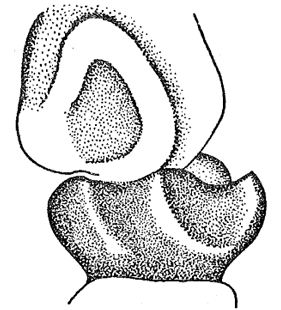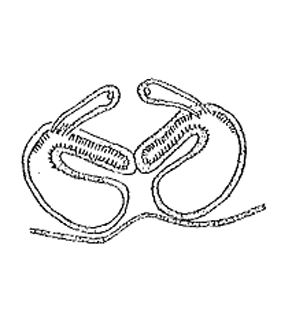Attulus goricus (Ovtsharenko, 1978)
Description
Male
Prosoma length: 1.95 mm, width 1.5 mm. Colouration generally like in the female but white setae on the eye region less numerous than in the female. Clypeus mostly without white setae, but upper fringe of anterior eyes with pronounced line of white setae. Leg colouration mostly as in the females. All femora yellow and darkened distal ends, all other segments darker. All patellae and tibia, especially in leg I, with darker sides (sometimes stripes). Metatarsus and tarsus II-IV lighter, without dark spots.
Opisthosoma almost black from above, with four well-expressed brown muscle spots. Several more brown spots give the impression of an oblong brownish spot on the dorsal side. Venter gray, with seperate light spots on the sides.
Palpus with numerous white setae on the dorsal sides of femur, patella and tibia.
Female
Prosoma length: 2.3 mm, width 1.95 mm. Tergum basically dark brown, eye region black, with a metallic tint and covered with white setae, especially in the area of the first eye row. The anterior median eyes and the clypeus are fringed with a dense row of white setae. A lighter median furrow originates just behind the third eye row. The rear slope of the carapace bears a dark reticulate pattern. Sternum brown, covered with long white setae. Chelicerae dark brown, frontal edge of cheliceral furrow with three teeth, posterior edge lacking teeth. Gnathocoxae light brown with white tips. Labium dark brown, bordered with a light fringe. Palpus light brown, all segments with white setae and distal segment with black setae. Legs dark yellow with large brown dorsal spots on patella, femur and tibia. Femora of all legs are lighter than the other segments. Claws with thick tufts of elongated setae.
Opisthosoma of brighter colour and densely covered with white, black and golden setae as well as five grooved black spots of black setae: one triangular in the anterior part, two in the central part and two in the posterior part. Venter dark yellow with a broad gray field in the center. Rear part of abdomen densely covered with white setae. Spinnerets yellow-gray.
Epigyne covered with white setae and bearing a posterior notch and two openings in the anterior half. Receptaculae partially transparent.
Additional information
In alpine and subalpine belts at altitudes betw. 1800 and 2600 m. Under rocks and pebbles. Females guard egg sacs under rocks.
Distribution
Phenology
| Jan | Feb | Mar | Apr | May | Jun | Jul | Aug | Sep | Oct | Nov | Dec |
 |  |
Figures
Distribution List
"No references" does not mean that the species does not occur in this country, but that we have not yet inserted the reference for it. We are working on it.
References
Otto S (2022) Caucasian spiders. A faunistic database on the spiders of the Caucasus Ecoregion. Database version 02.2022. Internet: caucasus-spiders.info.
Ovtsharenko V I (1978) Spiders of the family Salticidae (Aranei) from the Caucasus Major. Entomologicheskoe Obozrenie 57: 682-686 ![]()
Prószyński J (1987) Atlas rysunków diagnostycznych mniej znanych Salticidae 2. Zeszyty Naukowe Wyższej Szkoly Rolniczo-Pedagogicznej, Siedlcach, 172 pp. ![]()
WSC (2025) World Spider Catalog. Version 26. Natural History Museum Bern, online at http://wsc.nmbe.ch (28.2.2025) doi: 10.24436/2 ![]()
Updates
| 20-02-2019 | Datasheet update | Detail |
| 12-04-2017 | Image insert | |
| 11-11-2015 | Image insert |






